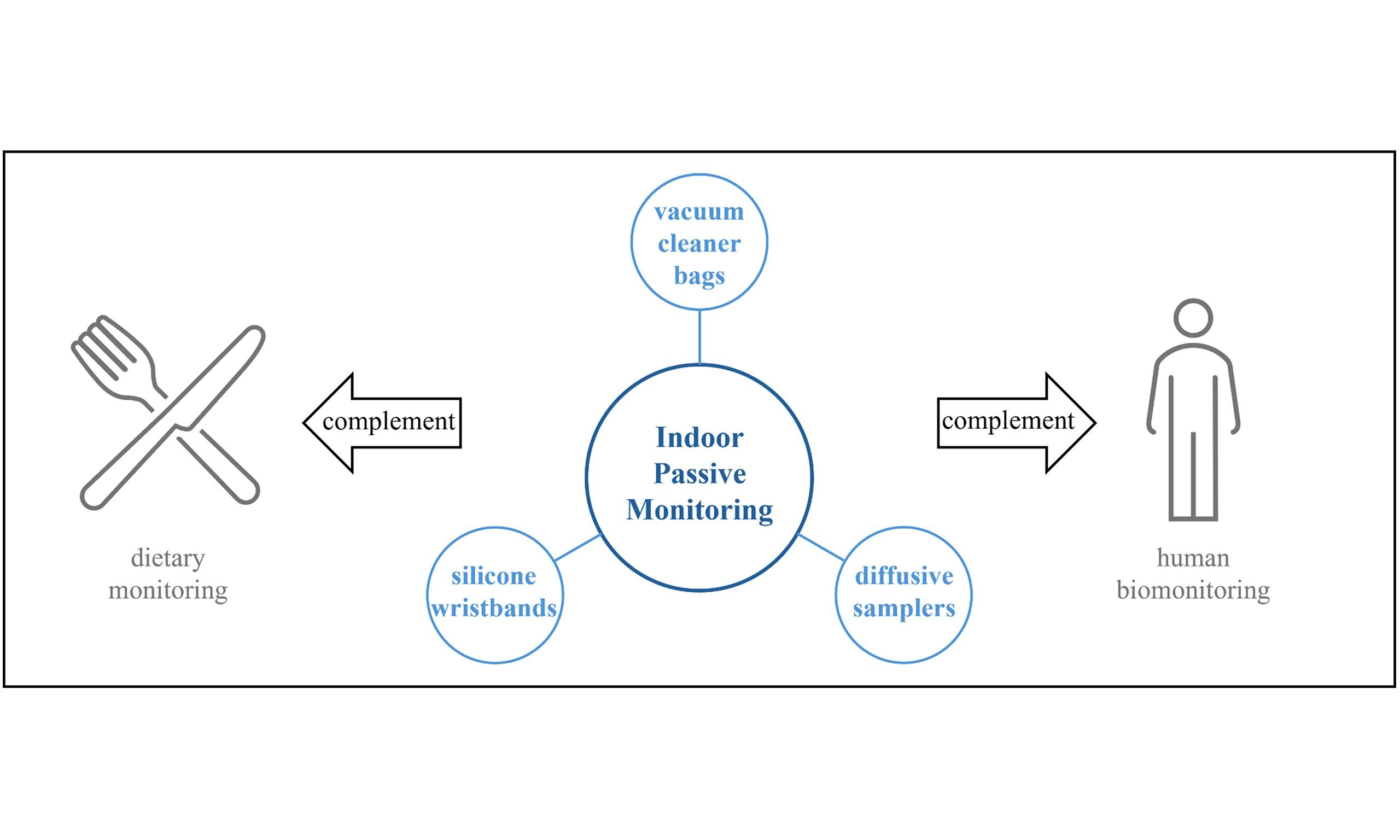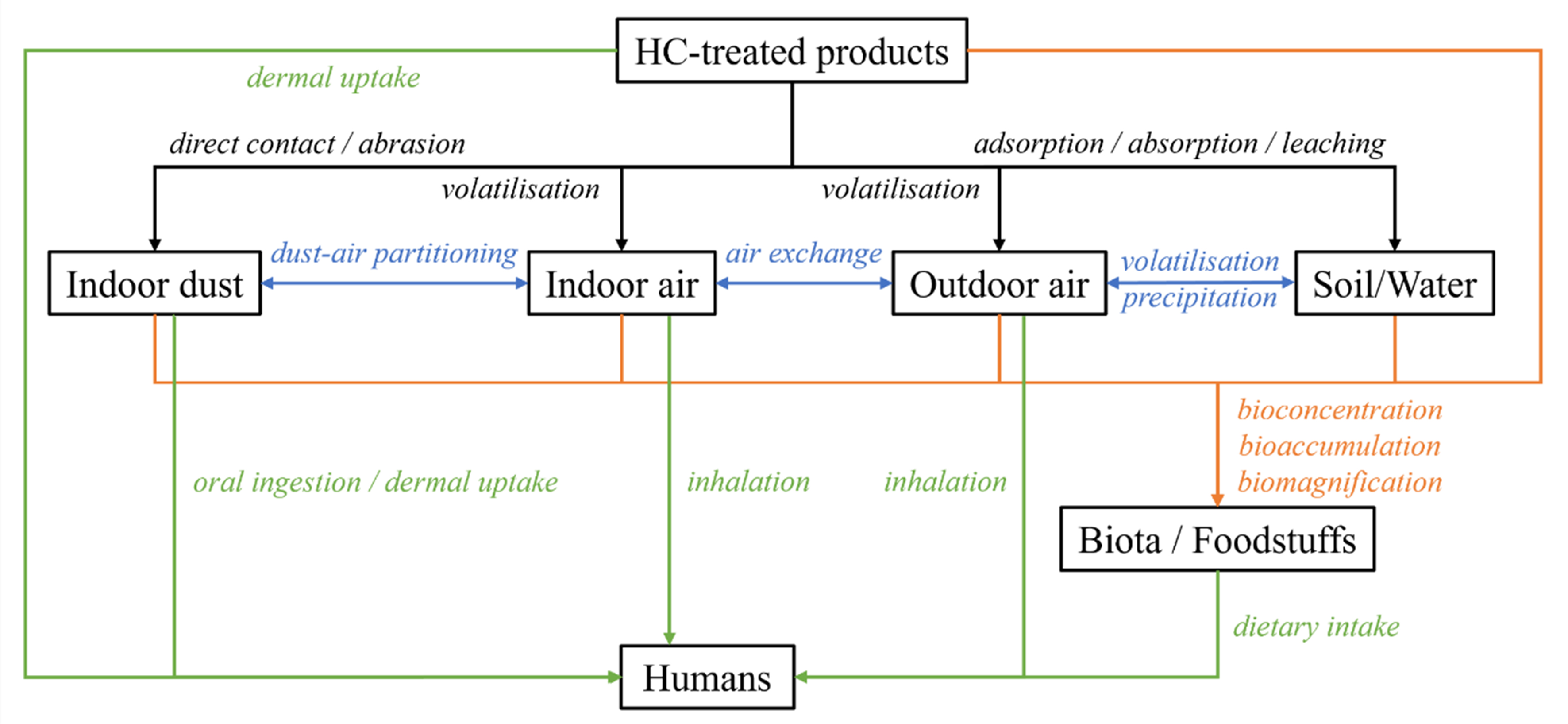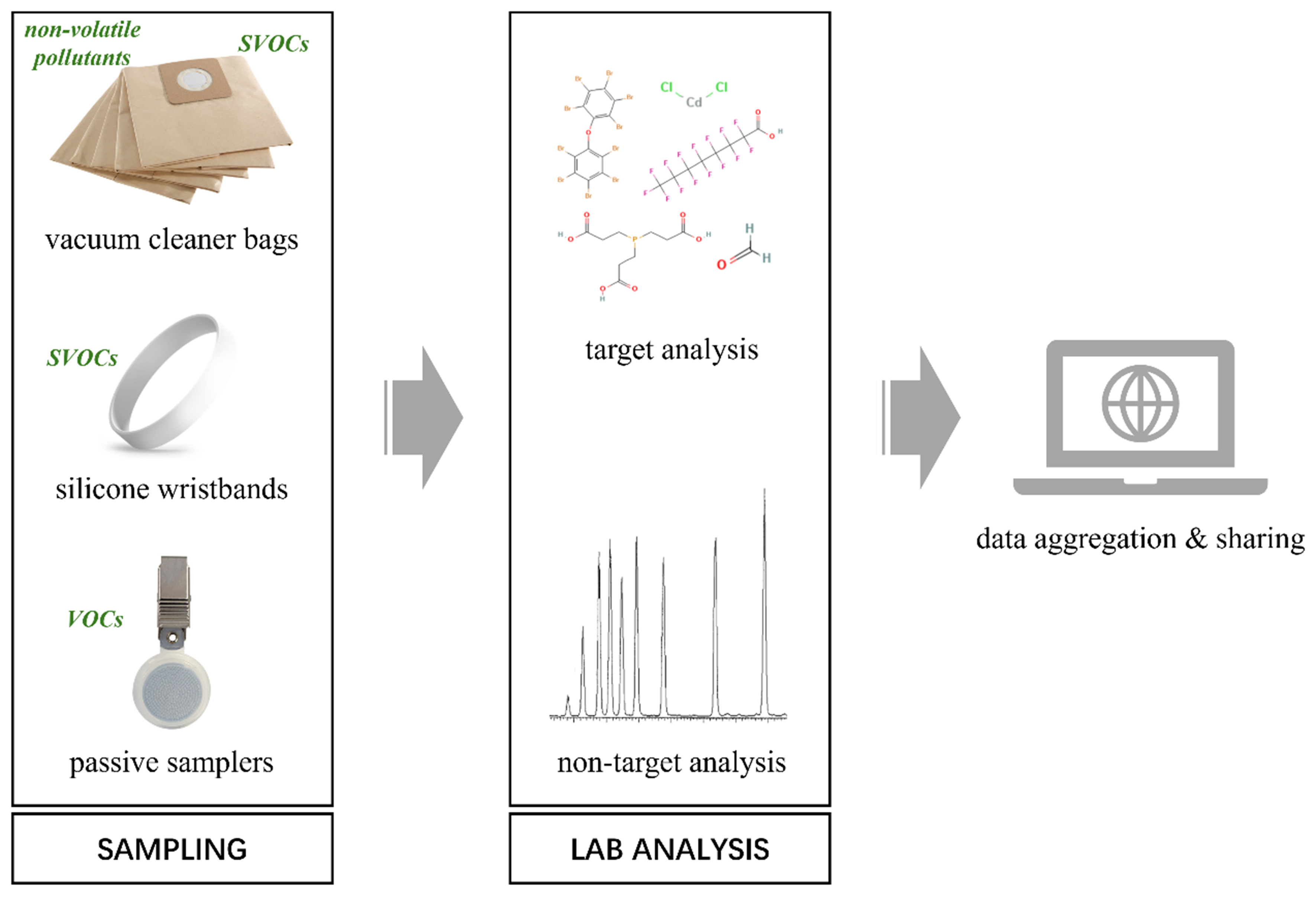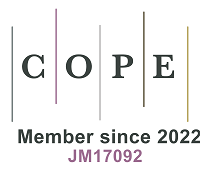An indoor passive monitoring programme to complement biomonitoring of population-level chemical exposures
Abstract
Approaches to characterising human exposure to hazardous environmental pollutants generally fall into two broad categories: external exposure monitoring vs. internal exposure monitoring (human biomonitoring). Time lags exist between the first use of chemicals, their initial occurrence in the abiotic environment, their emergence in the human diet, and their eventual manifestation in human bodies. We suggest that the optimum time to become aware of potentially problematic chemical exposures is at the earliest possible opportunity. Therefore, we propose an indoor passive monitoring programme as a complementary strategy to existing dietary exposure monitoring and human biomonitoring efforts. Indoor passive monitoring combining targeted analysis and non-target screening of vacuum cleaner dust, silicone wristbands, and passive air samplers, facilitates timely detection of emerging contaminants and assessment of human health risks, which is cost-effective and ethically advantageous. This indoor passive monitoring framework effectively leverages citizen science, enabling proactive interventions and improved public health outcomes.
Keywords
SHIFTING FOCI ON HUMAN EXPOSURE PATHWAYS OF ENVIRONMENTAL POLLUTANTS
Substantial research effort has been expended investigating adverse health effects of various hazardous environmental pollutants on humans, ranging from legacy contaminants like polychlorinated dibenzo-p-dioxins/polychlorinated dibenzofurans (PCDDs/PCDFs) and polychlorinated biphenyls (PCBs), to emerging pollutants such as novel brominated flame retardants (NBFRs) and per- and polyfluoroalkyl substances (PFAS). Chronologically, researchers’ attention has shifted from dietary exposure as the main exposure pathway of PCDDs/PCDFs[1,2], to a realisation that a more comprehensive combination of pathways contributes meaningfully to human exposure to a variety of pollutants[2-4]. Researchers have identified three principal pathways of human exposure to hazardous chemicals (HCs), i.e., inhalation of polluted air, oral intake of contaminated matrices (e.g., dust, food, water), and dermal contact with chemical-containing media/items (e.g., dust, portable devices, furniture)[3,4].
Previous studies demonstrate variations in the relative significance of these exposure pathways for different chemicals. For example, oral intake of diet and/or indoor dust generally contributes most to human exposure to hydrophobic pollutants possessing high KOW (n-octanol/water partition coefficient) values, such as PCDDs/PCDFs, PCBs, and BFRs[1,5], while the contribution of inhalation is elevated considerably for more volatile chemicals like organophosphate esters (OPEs) and some neutral PFAS[3,4]. By comparison, understanding of dermal exposure is limited, but recent evidence suggests that skin uptake is an important, potentially even dominant, pathway of human exposure to HCs such as lower KOW PFAS, BFRs, and OPEs[6-8].
Approaches to characterising chemical exposure essentially fall into one of two broad categories. The first is external exposure monitoring - in which concentrations of HCs in environmental media (both indoors and outdoors), human diet, and commercial products with which humans have contact, are multiplied by exposure factors (e.g., mass of a given foodstuff consumed per day as the approach to monitoring dietary exposure), and moderated by additional factors such as the percentage of chemical ingested that is absorbed by the body. The other broad approach is internal exposure monitoring, also known as human biomonitoring, in which chemicals and/or their metabolites are measured in human tissues (e.g., blood, adipose tissue) or excretions (e.g., urine), or secretions (e.g., breast milk). The best-known example of this approach is the US National Health and Nutrition Examination Survey (NHANES) program, while in Europe, major efforts are being made to develop and implement population-level biomonitoring via the Human Biomonitoring for Europe (HBM4EU) project. There are advantages and disadvantages to both approaches. While external exposure monitoring usually provides only a snapshot of exposure at a given time from one or more pathways and does not account for the efficiency of contaminant absorption by the body, it permits the characterisation of the relative importance of different exposure pathways[9]. In contrast, human biomonitoring reflects exposure integrated from all pathways over time and is ideal for assessing relationships between exposure and health outcomes, but it usually fails to pinpoint how such exposure has occurred. By definition, human biomonitoring approaches reveal exposures at a point when potential harm may already be occurring[10,11]. We thus contend that the ideal approach to monitoring population-level exposure to chemical contaminants would incorporate both external and internal exposure monitoring, and we submit that the optimum time to become aware of potentially problematic chemical exposures should be at the earliest possible opportunity.
THE GROWING NEED FOR INDOOR PASSIVE MONITORING
People typically spend most of their time indoors[12]. Indoor environments contain numerous consumer items like electronics and furniture. These items often contain a range of chemicals (e.g., flame retardants, plasticisers, stain- and grease-proofing agents, UV stabilisers) that can migrate from products to indoor dust and air through processes like abrasion, direct material-to-dust transfer, and volatilisation[13], making indoor environments a reservoir for potentially HCs, compounded by the low air volumes into which chemical emissions occur indoors. As a result, concentrations of such chemicals in indoor air and dust generally far exceed those in outdoor air and soil, leading to substantial human exposure to some chemicals in indoor environments[14-16], which may, in some instances, constitute the main pathway of exposure[16,17]. Logically therefore, we argue here for a programme that monitors indoor chemical contamination as the point in the transmission chain where many consumer chemicals make their first unrestrained appearance in the environment and where there is potential for human exposure.
The implementation of an indoor passive monitoring programme would serve as an early-warning sentinel approach that would complement dietary exposure monitoring programmes, such as: the Global Environment Monitoring System - Food Contamination Monitoring and Assessment Programme (GEMS/Food) run by the WHO, and the Total Diet Study (TDS) programmes administered by the Food Standards Agency (FSA) in England and Wales, and the Food and Drug Administration (FDA) in the USA. While dietary monitoring is clearly the best approach to monitoring exposure to contaminants directly introduced as food additives (e.g., trans fats, preservatives), via cooking processes [e.g., acrolein, polycyclic aromatic hydrocarbons (PAHs)], or via migration during packaging/storage (e.g., plasticisers, PFAS), current knowledge suggests that for bioaccumulative chemicals, the pathway from commercial products to human diet involves prolonged environmental migration via bioconcentration, bioaccumulation, and biomagnification[18,19]. This process may span months to decades, creating a considerable lag between contaminant release into the environment and detection by traditional food monitoring approaches for bioaccumulative chemicals. This lag time not only delays regulatory actions to mitigate environmental and health risks but also increases the complexity and cost of remediation. In contrast, the migration of HCs from products to indoor environments happens far more rapidly [Figure 1]. By integrating indoor passive monitoring with existing dietary monitoring programmes, we can achieve earlier detection of bioaccumulative contaminants, thereby facilitating earlier preventive interventions. Such a dual approach would address both direct foodborne contaminants (via diet monitoring) and indirect bioaccumulative threats (via indoor monitoring), ultimately strengthening holistic chemical management.
Figure 1. Illustrative diagram of HC migration from products to indoor/outdoor environmental media, biota/human diet, and human body. This diagram is extracted and modified from Ma[23]. Note that HC enrichment in the diet and the human body generally lags behind HC migration to indoor environments[2]. HC: Hazardous chemical.
As well as providing a pathway of direct human exposure via contact with indoor air and dust, indoor environments for many chemicals provide an indirect indicator of exposure via dermal contact with treated consumer goods (e.g., flame retarded furniture), and future exposure via the diet following ventilation to outdoor air and subsequent uptake into food chains[2]. While invaluable in its provision of unequivocal evidence of human exposure, human biomonitoring presents substantial hurdles with respect to ethical approval and sample collection (requiring trained medical professionals). Moreover, biomonitoring of toddlers and infants, two of the most vulnerable population sectors that are likely disproportionately exposed to indoor contamination[17], presents substantial ethical and practical issues. By comparison, citizen science, i.e., the involvement of the general public in scientific research in collaboration with or under the direction of scientists, could be a viable way of indoor sample collection (especially for dust), and presents fewer ethical challenges, making indoor passive monitoring a viable option to complement existing human biomonitoring programmes and an early warning system for emerging chemical exposure threats, especially for toddlers and infants.
KEY COMPONENTS OF A PROPOSED INDOOR PASSIVE MONITORING PROGRAMME
Figure 2 demonstrates key components of a viable indoor passive monitoring programme. Indoor dust is a complex but readily available matrix, facilitating the investigation of indoor contamination by a wide spectrum of chemicals, including semi-volatile organic compounds (SVOCs), persistent organic pollutants (POPs), heavy metals, etc. Household vacuum cleaner bags are disposable or reusable bags made of paper, cloth, or synthetic materials that are used in vacuum cleaners for dust collection. Vacuum cleaner bags are low-cost, commonly used, and easy to collect. They can collect a relatively large quantity of dust without much effort compared to brushes or handwipes, thereby constituting an efficient and economical approach to indoor dust sampling that is well-suited to citizen science. Although there could be uncertainties regarding the duration, coverage, and sampling technique, vacuum cleaner bags can provide a time-weighted integrated sample over a period (from days to months), which can be used for laboratory analysis of chemicals of interest. Once obtained, indoor dust samples can be analysed individually to provide the range of contamination within the population sampled, but if resources are scarce, they could also be pooled to provide an indicator of contaminant exposure on a whole population scale.
Indoor dust samples (whether from individual donors or pooled) can be analysed in two ways. Specifically, for a list of target chemicals of concern, indoor dust can be analysed to facilitate the assessment of direct exposures to such chemicals via contact with indoor dust (i.e., dust ingestion and dermal uptake), and used alongside mathematical modelling approaches to estimate dietary exposure. Additionally (or alternatively), non-target chromatographic-mass spectrometric screening approaches can be deployed to identify and provide semi-quantitative data on the presence of emerging chemicals in indoor environments. Data from the latter approach can identify new chemical exposures at either the individual or population level - indeed, recent analysis of a composite European house dust sample by several different laboratories has identified ~1,200 anthropogenic chemicals, all of which, by inference, have human exposure potential via one or more pathways[20]. Such non-target screening approaches complement available production and use information and help focus risk assessment on those chemicals to which the population is most exposed, as well as identifying emerging exposure threats. The scientific literature, as well as regulatory data for those chemicals identified, could then be used to consider risk and identify potentially problematic chemicals before extensive, prolonged exposure occurs.
In addition to vacuum cleaner dust, which is particularly effective in capturing less volatile contaminants, personal wearable articles can be used as complementary approaches to environmental pollutant monitoring and human exposure assessment for contaminants with higher vapour pressures as well as inhalation exposure to semi-volatile contaminants. Silicone wristbands are an affordable, non-invasive, and user-friendly tool that can be easily deployed on a large scale without requiring specialised training or equipment. This accessibility makes silicone wristbands particularly suitable for vulnerable populations like children, thereby complementing current human biomonitoring practices. That wristbands have direct skin contact means that they can integrate inhalation and dermal exposures to a wide range of SVOCs and POPs simultaneously[21]. Moreover, they may also be used as a tool for non-target screening of the presence of emerging chemicals that have skin contact and respiratory exposure potential.
With respect to VOCs (e.g., formaldehyde, benzene, toluene), commercial organic vapour passive (diffusive) samplers or “badges” are an economical alternative to active samplers used to monitor inhalation exposure[22]. VOCs are simply sorbed from the atmosphere into passive samplers at a fixed rate, and can be easily desorbed with solvents or thermally for laboratory analysis via GC-MS. Like silicone wristbands, the “badges” are affordable and non-invasive, and can be easily deployed across a large population, including vulnerable groups. Further, these passive samplers may be easily deployed in indoor environments without too much effort, such as daycare centres, classrooms, and hospitals, so that a map of VOC contamination can be drawn at a relatively low cost.
CONCLUSIONS
To mitigate time lags between the first use of chemicals, their initial occurrence in the abiotic environment, and their eventual emergence in the human diet and human bodies, we propose an indoor passive monitoring programme as a complement to ongoing dietary exposure monitoring and human biomonitoring programmes. Target screening of vacuum cleaner dust, complemented with silicone wristbands and passive samplers, enhances public health protection by prioritising risk assessment for vulnerable populations and high-exposure chemicals. Meanwhile, non-target screening approaches can provide an invaluable early warning of exposure to emerging pollutants and empower regulators to take early action to limit exposure and consequent harm. Overall, this proposed indoor passive monitoring programme aims to establish a systematic framework for assessing human exposure risks, with sufficient flexibility to allow researchers and regulators to design a programme suited to the available resources. We contend that this holistic approach lays a scientific foundation for proactive environmental health risk management, ensuring safer indoor spaces and informed policy decisions.
DECLARATIONS
Acknowledgements
This work was supported by the INVEST pFASST project (project code: 2022-HE-1148).
Authors’ contributions
Conceptualisation and methodology, data collection and interpretation, visualisation, writing - original draft, writing - review and editing: Ma, Y.
Conceptualisation and methodology, project administration, writing - review and editing: Harrad, S.
Availability of data and materials
Not applicable.
Financial support and sponsorship
None.
Conflicts of interest
Harrad, S. is the Editor-in-Chief of Journal of Environmental Exposure Assessment. Ma, Y. is a Junior Editorial Board member of Journal of Environmental Exposure Assessment. Harrad, S. and Ma, Y. were not involved in any steps of editorial processing, notably including reviewer selection, manuscript handling, or decision making.
Ethical approval and consent to participate
Not applicable.
Consent for publication
Not applicable.
Copyright
© The Author(s) 2025.
REFERENCES
1. Fiedler, H. Dioxins and furans (PCDD/PCDF). In: Fiedler H, editor. Persistent organic pollutants. Berlin/Heidelberg: Springer-Verlag; 2003. pp. 123-201.
2. Harrad, S.; Diamond, M. New directions: exposure to polybrominated diphenyl ethers (PBDEs) and polychlorinated biphenyls (PCBs): current and future scenarios. Atmos. Environ. 2006, 40, 1187-8.
3. Hu, Z.; Yin, L.; Wen, X.; et al. Organophosphate esters in china: fate, occurrence, and human exposure. Toxics 2021, 9, 310.
4. Jian, J. M.; Guo, Y.; Zeng, L.; et al. Global distribution of perfluorochemicals (PFCs) in potential human exposure source - a review. Environ. Int. 2017, 108, 51-62.
5. Fiolet, T.; Casagrande, C.; Nicolas, G.; et al. Dietary intakes of dioxins and polychlorobiphenyls (PCBs) and breast cancer risk in 9 European countries. Environ. Int. 2022, 163, 107213.
6. Ragnarsdóttir, O.; Abdallah, M. A.; Harrad, S. Dermal uptake: an important pathway of human exposure to perfluoroalkyl substances? Environ. Pollut. 2022, 307, 119478.
7. Liu, X.; Yu, G.; Cao, Z.; et al. Estimation of human exposure to halogenated flame retardants through dermal adsorption by skin wipe. Chemosphere 2017, 168, 272-8.
8. Frederiksen, M.; Stapleton, H. M.; Vorkamp, K.; et al. Dermal uptake and percutaneous penetration of organophosphate esters in a human skin ex vivo model. Chemosphere 2018, 197, 185-92.
9. Papadopoulou, E.; Padilla-Sanchez, J. A.; Collins, C. D.; et al. Sampling strategy for estimating human exposure pathways to consumer chemicals. Emerg. Contam. 2016, 2, 26-36.
10. Bao, J.; Ren, H.; Han, J.; Yang, X.; Li, Y.; Jin, J. Levels, tissue distribution and isomer stereoselectivity of Dechlorane Plus in humans: a critical review. Sci. Total. Environ. 2023, 903, 166156.
11. Ojo, A. F.; Peng, C.; Ng, J. C. Assessing the human health risks of per- and polyfluoroalkyl substances: a need for greater focus on their interactions as mixtures. J. Hazard. Mater. 2021, 407, 124863.
12. Wilford, B. H.; Harner, T.; Zhu, J.; Shoeib, M.; Jones, K. C. Passive sampling survey of polybrominated diphenyl ether flame retardants in indoor and outdoor air in Ottawa, Canada: implications for sources and exposure. Environ. Sci. Technol. 2004, 38, 5312-8.
13. Ma, Y.; Stubbings, W. A.; Abdallah, M. A.; Cline-Cole, R.; Harrad, S. Formal waste treatment facilities as a source of halogenated flame retardants and organophosphate esters to the environment: a critical review with particular focus on outdoor air and soil. Sci. Total. Environ. 2022, 807, 150747.
14. Cao, Z.; Xu, X.; Zhao, Y.; et al. Gas-particle partition and size-segregated distribution of flame retardants in indoor and outdoor air: reevaluation on the role of fine particles in human exposure. Chemosphere 2022, 292, 133414.
15. Massolo, L.; Rehwagen, M.; Porta, A.; Ronco, A.; Herbarth, O.; Mueller, A. Indoor-outdoor distribution and risk assessment of volatile organic compounds in the atmosphere of industrial and urban areas. Environ. Toxicol. 2010, 25, 339-49.
16. Wang, J.; Wang, Y.; Shi, Z.; Zhou, X.; Sun, Z. Legacy and novel brominated flame retardants in indoor dust from Beijing, China: occurrence, human exposure assessment and evidence for PBDEs replacement. Sci. Total. Environ. 2018, 618, 48-59.
17. Li, J.; Dong, Z.; Wang, Y.; et al. Human exposure to brominated flame retardants through dust in different indoor environments: identifying the sources of concentration differences in hair from men and women. Chemosphere 2018, 205, 71-9.
18. Chormare, R.; Kumar, M. A. Environmental health and risk assessment metrics with special mention to biotransfer, bioaccumulation and biomagnification of environmental pollutants. Chemosphere 2022, 302, 134836.
19. Katagi, T. Bioconcentration, bioaccumulation, and metabolism of pesticides in aquatic organisms. Rev. Environ. Contam. Toxicol. 2010, 204, 1-132.
20. Haglund, P.; Alygizakis, N. A.; Covaci, A.; et al. Comprehensive characterization of European house dust contaminants: concentrations and profiles, geographical variability, and implications for chemical regulation and health risk. Sci. Total. Environ. 2024, 957, 177639.
21. Wang, S.; Romanak, K. A.; Stubbings, W. A.; et al. Silicone wristbands integrate dermal and inhalation exposures to semi-volatile organic compounds (SVOCs). Environ. Int. 2019, 132, 105104.
22. Crump, D. Application of diffusive samplers. In: Organic indoor air pollutants: occurrence, measurement, evaluation. Wiley‐VCH Verlag GmbH & Co. KGaA; 2009. pp. 47-63.
23. Ma, Y. Temporal changes in halogenated flame-retardant concentrations in foodstuffs and indoor and outdoor environments: implications for human exposure. 2024. https://etheses.bham.ac.uk/id/eprint/14486/. (accessed 27 Jun 2025).
Cite This Article
How to Cite
Download Citation
Export Citation File:
Type of Import
Tips on Downloading Citation
Citation Manager File Format
Type of Import
Direct Import: When the Direct Import option is selected (the default state), a dialogue box will give you the option to Save or Open the downloaded citation data. Choosing Open will either launch your citation manager or give you a choice of applications with which to use the metadata. The Save option saves the file locally for later use.
Indirect Import: When the Indirect Import option is selected, the metadata is displayed and may be copied and pasted as needed.
About This Article
Copyright
Data & Comments
Data



















Comments
Comments must be written in English. Spam, offensive content, impersonation, and private information will not be permitted. If any comment is reported and identified as inappropriate content by OAE staff, the comment will be removed without notice. If you have any queries or need any help, please contact us at support@oaepublish.com.